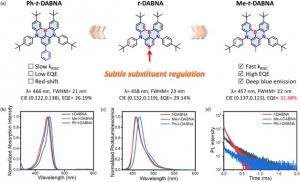Tiny Molecular Tweak Boosts Deep-Blue OLED Efficiency to World-Leading Levels
Chinese researchers achieve brighter, more efficient, and color-accurate OLED displays through a simple chemical modification.
Even a small chemical change can lead to major performance gains. Our work provides a practical blueprint for designing next-generation OLED materials.”
HAIDIAN, BEIJING, CHINA, October 31, 2025 /EINPresswire.com/ -- Researchers from the South China University of Technology, Jihua Laboratory, and Jilin University have developed a new way to make deep-blue OLED (organic light-emitting diode) devices more efficient without compromising on color quality. Their study, published in FlexTech, introduces a simple yet powerful molecular adjustment that could help shape the future of high-end display technologies.— Dr. Wang Jiaxuan, Jihua Laboratory
One Small Change, Triple Impact
The teams led by Professor Peng Junbiao and Dr. Wang Jiaxuan focused on a well-known OLED material called t-DABNA, used in multi-resonance thermally activated delayed fluorescence (MR-TADF) emitters. These materials are key to achieving rich, pure colors in energy-efficient OLED screens.
In their latest work, the researchers replaced a single chemical group in the molecule, swapping a phenyl for a tiny methyl group. This seemingly small change made a big difference:
● Maintained perfect color purity: Deep-blue emission at 457 nm, with an exceptionally narrow spectrum (22 nm).
● Tripled efficiency speed: The reverse intersystem crossing rate (known as kRISC) increased threefold, improving light output.
● Reduced energy waste: The material’s delayed fluorescence time was shortened by more than half, helping maintain brightness at high power.
The result was a next-generation OLED device that reached a world-leading 32.48% external quantum efficiency (EQE), vivid deep-blue color close to the BT.2020 display standard, and an ultrahigh brightness of 11,619 cd/m² all while keeping energy loss impressively low.
Why Deep-Blue OLEDs Matter
OLEDs are already used in premium smartphones, TVs, and wearable devices, prized for their rich colors, thinness, and flexibility. However, creating a true, energy-efficient deep-blue light has been one of the biggest challenges in display engineering. Blue light requires high energy and precise control; any instability can quickly lead to poor efficiency or color fading.
Traditional materials could boost brightness, but usually at the cost of color purity. The new “methyl substitution” approach solves that trade-off, allowing both qualities to coexist.
Science Behind the Innovation
The team used advanced computer modeling (TD-DFT calculations) to understand why the methyl group improved performance. They found that it narrowed the energy gap between molecular states, promoting efficient energy transfer and light emission while not affecting the blue color.
In contrast, replacing methyl with a bulkier phenyl caused unwanted color shifts and slower energy conversion, proving that precision is key in molecular design.
Conclusion
This study demonstrates that precise, minimal molecular modifications can deliver significant improvements in OLED performance. By introducing a single methyl group into t-DABNA, the researchers achieved world-leading efficiency, high brightness, and pure deep-blue emission all without compromising color quality.
The findings not only solve a long-standing challenge in deep-blue OLED development but also provide a practical design strategy for future high-performance display materials. With both scientific and industrial significance, this breakthrough paves the way for next-generation OLED screens in smartphones, televisions, and wearable devices, strengthening the foundation for China’s growing OLED industry.
About the Journal – FlexTech
FlexTech is an international journal sponsored by Tsinghua University, edited and published by Tsinghua University Press in partnership with Wiley. It focuses on flexible electronics and advanced materials for next-generation technologies.
Journal Website: https://onlinelibrary.wiley.com/journal/27711714
Submission Portal: https://wiley.atyponrex.com/journal/FLE2
Read the full article here: http://doi.org/10.1002/fle2.70005
Andrew Smith
Charlesworth Publishing Limited
+44 7753 374162
marketing@charlesworth-group.com
Visit us on social media:
LinkedIn
YouTube
Other
Legal Disclaimer:
EIN Presswire provides this news content "as is" without warranty of any kind. We do not accept any responsibility or liability for the accuracy, content, images, videos, licenses, completeness, legality, or reliability of the information contained in this article. If you have any complaints or copyright issues related to this article, kindly contact the author above.


